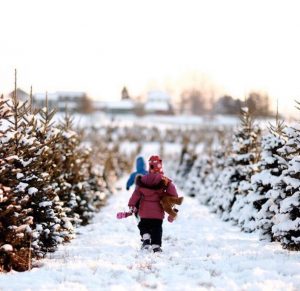Going for a fresh Christmas tree? Read this before heading out
Chronicle Media — December 3, 2016

Fir trees make lovely Christmas trees due to their shorter needles but are usually considerably more expensive.
There is nothing like the smell of a fresh Christmas tree to put you in the holiday spirit. Rhonda Ferree, horticulture educator with University of Illinois Extension, provides the following tips to help you choose the perfect tree for your home and assure it stays fresh throughout the holiday season.
Ferree says that the first step to the perfect tree is selection. The most popular cut tree sold is the Scotch pine, but there are other types available too. Scotch pines are often locally grown and are usually cheaper than other types. Other common Christmas trees include Douglas fir, balsam fir, white fir, and my favorite, the Fraiser fir.
Fir trees make lovely Christmas trees due to their shorter needles but are usually considerably more expensive. Colorado blue spruce and other spruces typically do not make a good Christmas tree. White pine makes a beautiful Christmas trees, but the branches are soft and do not hold heavy ornaments well.
Whatever type you prefer, look for quality in the tree. It should be fresh, clean, well-trimmed, and have a good shape. The freshness of a tree is directly related to the moisture content of its needles. The best way to assure a tree is fresh is to cut it yourself or buy it from a reliable dealer. You can also test for freshness on the sales lot.
Fresh trees have firm needles that are not brittle when grasped. (However, if temperatures are near zero, even a fresh tree will have brittle needles.) They will have a strong fragrance and good natural green color. However, some trees are sprayed with a colorant. Shake the tree. According to Ferree, if a lot of outer green needles fall to the ground, it is probably too dry.
Once the tree is home, always re-cut the base and put the tree into a bucket of water. Although that fresh cut is often a hassle, it is necessary. Whenever the stem end of a fresh cut tree is exposed to air, a seal forms.
The tree cannot take up water through that seal and will dry out. The only way to prevent the seal from forming is to make a fresh cut anytime the tree is taken out of the water.
If you are not ready to bring the tree into the house, store it in a garage or outside away from winds. Once inside, expect a fresh-cut tree to use one-half to two gallons of water the first day. Check it several times the first day.
Use a tree stand that holds plenty of water to assure your tree doesn’t dry out. After the first day, the tree will use less water throughout the holiday season as it adjusts to the indoor environment.
Ideally, the trees should be displayed in a location out of direct sunlight and away from sources of heat or flame. If you must place the tree in one of these spots, make sure fresh water is provided every day.
Ferree says that it is not necessary to add anything to the water for your Christmas tree. Do not add aspirin, sugar, soda pop, or anything else to the water. All your tree requires is clear, cool, fresh water, and lots of it.
More information is found at the University of Illinois Extension Christmas Tree & More website at http://extension.illinois.edu/trees.
— Going for a real Christmas tree? Read this before heading out —







